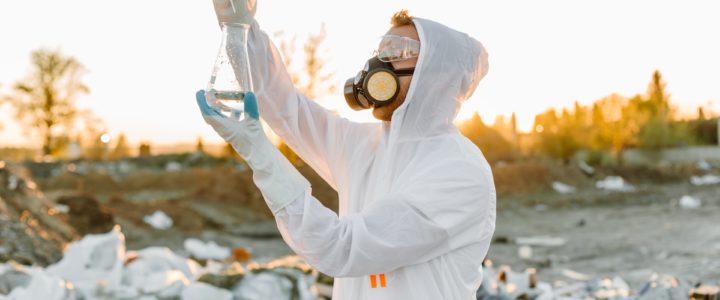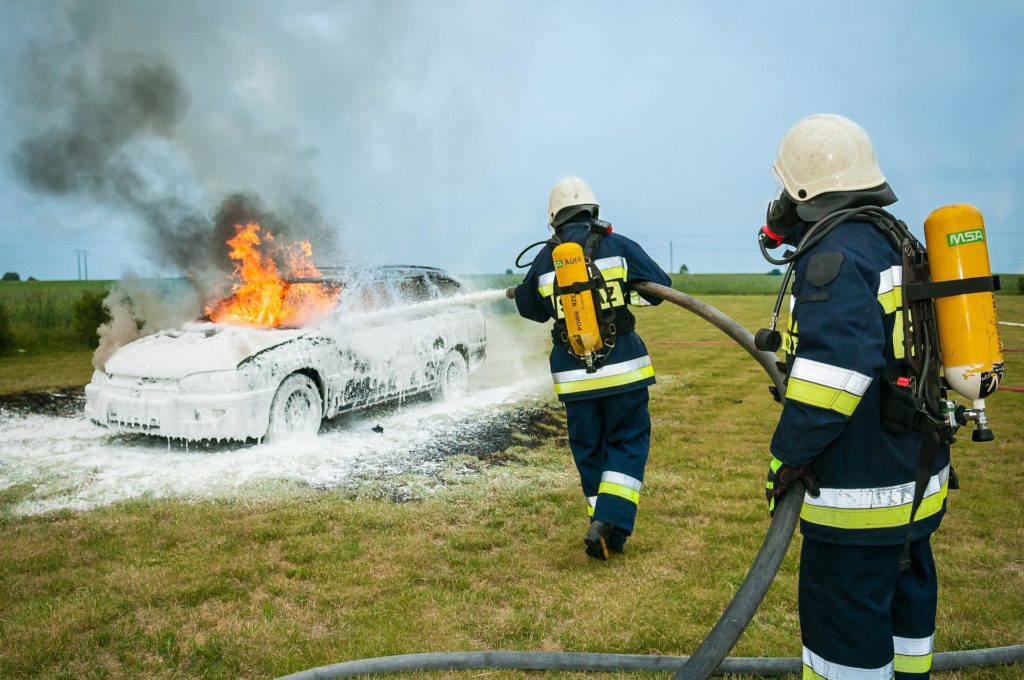
PFAS, usually pronounced Peafass, is an acronym which we’re hearing a lot about lately. Even though it might be new to your vernacular you’ve likely been very up close and personal with it for decades. PFAS stands for Per- and Polyfluoroalkyl Substances, and they are also called “Forever Chemicals”. There are thousands of these chemicals and they’ve been a common part of our lives since the 1940s. In truth, they’re hard to avoid, present in an extremely long list of consumer, commercial and industrial products, like mattresses, cosmetics, non-stick cookware like Teflon, stain- and water-resistant textiles like Goretex, carpet, metal finishing and plating, hydraulic fluids, electronics, takeaway food packaging and firefighting foam. The chemicals are resistant to heat, water and oil – giving them a huge appeal for the above uses. But they are also resistant to degradation in our natural environment – meaning they are simply moved from place to place while still intact and damaging. They’ve been found in all corners of the globe, including in the remote Arctic. But perhaps even more worrying is that they’re appearing in our drinking water, and ergo, our bodies, accumulating and causing long term and serious health impacts. There would certainly be damaging levels in wildlife too, but so far this has not been studied to apply definite findings.
Two of these chemicals which have had the greatest amount of study dedicated to them and have hence been of greatest concern, are PFOA (perfluorooctanoic acid) and PFOS (perfluorooctanesulfonic acid). Firefighting foams, used by the tons to extinguish petroleum based fires, and proven to cause contamination to ground water, contain both of these chemicals. Concern grew so great about the effects caused to the human body by exposure to these substances that in 2019 180 countries across the globe agreed to ban or heavily restrict the use of PFOA. This came into effect in July 2020 under the Stockholm Convention – which the United States is not an official treaty partner of, so whom did not adopt these restrictions.

The other complication is that due to there being in excess of 4,700 PFAS chemicals, there is always an alternative one available for use whenever a specific one has restrictions applied. Despite very heavy restrictions, the amount of PFAS in the environment and our bodies is only increasing. So five member nations of the EU: Germany, the Netherlands, Denmark, Norway and Sweden; have petitioned to have EU wide restrictions on all PFAS chemicals. While those which are already at-large in the environment won’t be going anywhere, we could feel slightly bolstered by the the limitation of more being added.
Even though the US didn’t apply restrictions a couple of years ago along with 180 other countries, there has been continued concern and behind the scenes work to establish a level of risk. And the EPA have now announced that this risk is very high indeed! Previous health advice was that 70 parts per trillion could potentially lead to health impacts. But recent studies have found that lifetime exposure levels as low as 0.004 parts per trillion can compromise the immune and cardiovascular systems, and a level of 0.02 parts per trillion has been linked to decreased birth weights. But most alarmingly, the studies have found that there may be negative health impacts when the levels are even below those detectable by the EPA. The issue will be addressed by the EPA placing mandatory standards for the levels of PFAS in drinking water across the United States, which have been described as ‘aggressive measures’. $1 Billion, which is part of the Infrastructure Bill, is set to be rolled out soon, and will be used to provide states with technical assistance, water quality testing and installation of centralized treatment systems. They’ve identified 120,000 locations where people may be exposed to PFAS.

Of course there’s been some backlash to the extremely fast and hardline response by the EPA – notably from 3M and DuPont. If you’ve seen the 2019 film Dark Waters you’d be familiar with the DuPont name. The film, based on a true story, describes how and why DuPont were at the center of an enormous battle against a small town lawyer, Rob Bilott, resulting in class actions and settlements of around $753 Million, to date. The epidemiological studies which were undertaken as a result of this case being brought, and included 69,000 people, linked PFOA to a range of diseases, including kidney and testicular cancer.
But now for some good news! Some research recently published by the EPA, in the Journal of Environmental Engineering, found that these indestructible substances may, in fact, be mostly destructible! Using a high heat- and pressure- based technique called supercritical water oxidation can destroy up to 99% of PFAS present in water. The contaminated water is subjected to heat of over 374 degrees Celsius and pressure of over 220 bars. This creates what’s known as supercritical water: it is no longer a liquid but nor is it a gas. And in this state, even PFASs are more readily dissolved. This technique itself isn’t new, being used to breakdown various other chemicals, but this is the first time it’s been trialed with PFASs in a peer-reviewed study. And the findings are exciting! Not least of which because supercritical water oxidation systems are already commercially available, meaning time to launch this solution for cleaning up waterways might be in the near future.
But – we can’t rely only on tech. So with this stuff so abundant all around us, we must put in a concerted effort to avoid it. So here are some suggestions for minimizing your exposure to this harmful group of chemicals:
✦ Ditch the non-stick cookware. Heating PFAS to high temperatures causes the fumes to be released, and can be enough to give humans flu-like symptoms and even kill small pet birds! So try to access cast iron or stainless steel cookware instead. And remember there are over 4,700 PFAS chemicals…that means that even if your cookware states PFOA free, there’s another alternative one in there.
✦ If all you can access is non-stick cookware, don’t ever pre-heat it, don’t ever put it in the oven, and don’t ever use steel wool or anything else hard or sharp. Keeping the surface in tact and under temperatures of 400 degrees F (204 degrees C) will help reduce the risk of the fumes or your food absorbing the chemicals.

✦ Take your own containers to collect take-out. This solution reduces plastic waste and you’re not ordering a side of PFAS! But the presence of this chemical is even in burger wrappers at Burger King (they’ve announced a global ban to come into action in 2025) and cookie bags at McDonalds. So if you’re using a fast food outlet, remove the food from the packaging as quickly as you can, and never reheat it in the packaging. Also consider signing the Consumer Reports petition to fast food giant Arby’s to remove PFAS from their packaging.
✦ If you get your drinking water from a private well, it would be advisable to test for PFAS. While the EPA don’t regulate this water, or testing of it, they can be a good resource for doing this yourself.
✦ If you eat locally caught fish, you can check with your local State, Territory and Tribal Fish Advisory Councils to determine if your waterways are of concern for PFAS levels.
✦ Avoid pre-made bags of microwave popcorn. They are high in PFAS levels, and you have no choice but to heat them to high temps. Pop your own instead.
✦ Research water and stain resistant fabrics, like outdoor/hiking gear, mattresses and soft furnishings – find those which have limited their use of PFAS. You’ll want to try avoiding brands which use Goretex or Scotchguard. If your carpeting your place, ask for PFAS-free or non treated – there’s not many currently available, and this is one way that we can show consumer demand for safer alternatives.
✦ Look for PTFE, “perfluor” or “fluoro-” on labels of skincare, personal care and cosmetics…and then don’t buy them! It’s been discovered that lots brands use these chemicals. You can use the Environmental Working Group website to find out if your favorite brands use any of a whole host of toxic ingredients.
✦ Keep up to date with the changes the EPA are bringing in, specifically regarding drinking water, and support Clean Water Action by signing their petitions and learning more about the issues.
The bad news is that this stuff is likely to be something we’re dealing with for many many decades, and it’s extremely harmful. The good news is that the EPA are now onto it, and will work towards making appropriate changes to increase the safety of the US people, like many countries in Europe have already done. And in the meantime, there’s some ways you can minimize your own exposure. Here is a great resource to find PFAS-free products! Bear in mind this should be looked at through a multitude of lenses…that is to say, being PFAS-free doesn’t mean that a certain clothing manufacturer, for example, should be allowed to commit moral and ethical crimes, or create a different type of environmental damage. In the words of the great K. Frog, It’s not easy being green. But to quote Sidney Sheldon, surely we must Try to leave the Earth a better place than when you arrived. I’m definitely down with that – difficult as it sometimes is. And we know you are too, swrmers…so thank you, for all do you!



